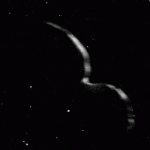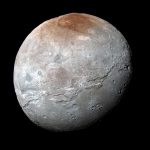If Pluto has a subsurface ocean, it may be old and deep0
- From Around the Web, Space
- April 1, 2020
New research hints that liquid water might be common at the solar system’s edge

New research hints that liquid water might be common at the solar system’s edge

Data from NASA’s New Horizons mission are providing new insights into how planets and planetesimals — the building blocks of the planets — were formed.

About a billion miles more distant than Pluto is Ultima Thule, a peanut-shaped object in the outer solar system that’s the farthest place ever visited by humans.

New images reveal the skinny side of the Kuiper Belt object

New images from NASA’s New Horizons spacecraft — taken from as close as 17,000 miles (27,000 km) on approach — revealed Ultima Thule as a contact binary.

On 1 January 2019 the New Horizons probe will begin transmitting data from Ultima Thule, 4bn miles from Earth in the Kuiper belt. What will it find?

NASA’s New Horizons team has released the first official global mosaic and topographic maps of the dwarf planet Pluto and its largest moon, Charon.

The largest of Pluto’s five moons, Charon, was discovered 40 years ago today by James Christy and Robert Harrington at the U.S. Naval Observatory in Flagstaff, Arizona – only about six miles from where Pluto itself was discovered at Lowell Observatory. They weren’t even looking for satellites of Pluto – Christy was trying to refine Pluto’s orbit around the Sun.

Hibernation season is over for NASA’s New Horizons probe.

Scientists have discovered dunes on Pluto, and say they are likely to have been formed of methane ice grains released into its rarefied atmosphere.



